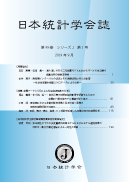Volume 49, Issue 1
Displaying 1-6 of 6 articles from this issue
- |<
- <
- 1
- >
- >|
Articles
-
2019Volume 49Issue 1 Pages 1-21
Published: September 30, 2019
Released on J-STAGE: April 02, 2020
Download PDF (694K) -
2019Volume 49Issue 1 Pages 23-60
Published: September 30, 2019
Released on J-STAGE: April 02, 2020
Download PDF (1884K)
Special Section: Analyzing Socio-Economic Issues with Spatial Data and GIS
-
2019Volume 49Issue 1 Pages 61-82
Published: September 30, 2019
Released on J-STAGE: April 02, 2020
Download PDF (3235K) -
Article type: research-article
2019Volume 49Issue 1 Pages 83-114
Published: September 30, 2019
Released on J-STAGE: April 02, 2020
Download PDF (5088K) -
Article type: research-article
2019Volume 49Issue 1 Pages 115-131
Published: September 30, 2019
Released on J-STAGE: April 02, 2020
Download PDF (2295K)
Special Topic: The JSS Research Prize Lecture
-
Article type: research-article
2019Volume 49Issue 1 Pages 133-159
Published: September 30, 2019
Released on J-STAGE: April 02, 2020
Download PDF (725K)
- |<
- <
- 1
- >
- >|
